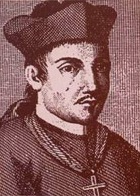| Antonio Sebastiano Minturno | |
|---|---|
 Antonio Sebastiano Minturno Antonio Sebastiano Minturno | |
| Born | 1500 Minturno, Kingdom of Naples |
| Died | 1574 (aged 73–74) Crotone, Kingdom of Naples |
| Occupation | Poet, critic, and bishop |
| Language | Italian |
| Nationality | Napoletano |
| Period | Late Middle Ages |
| Literary movement | Renaissance |
| Notable works | De Poeta L'Arte Poetica |
Antonio Sebastiano Minturno (1500–1574) was an Italian poet and critic, and Bishop of Ugento. His influential literary theories were largely Aristotelian. He was born at Minturno, then part of the Kingdom of Naples.
Biography
The name Minturno, by which alone Sebastiano is remembered, is said to have been taken from an old city in the Kingdom of Naples named Minturna, which had existed near Traetto where he was born. He studied philosophy with Agostino Nifo in Naples, and followed him to Sessa and Pisa. In 1521 he went to Rome, where he was protected by the Colonnas. In their castle of Genazzano he learned Greek from a certain maestro Paolo, and made some progress in Hebrew. In order to escape the plague he left Rome in 1523 and returned to Sessa, where he studied mathematics, and thence to Naples. At this time he took up the composition of vernacular verse. The wars caused him to remove to Sicily, where the viceroy Monteleone welcomed him and granted him a pension of 200 ducats. In 1559 Minturno became Bishop of Ugento, and in that capacity attended the Council of Trent. In 1565 he was transferred to the bishopric of Crotone, where he died in 1574.
Works
He wrote three collections of poems in Latin: Carmina (1548), Poemata (1562), and Poemata Tridentina (1564, written during the Council of Trent). He intensely admired the sonnets of Petrarch. In 1559 he wrote the critical work De Poeta, a lengthy dialogue in which he maintains the Aristotelian idea of tragedy as a lesson to the audience on the transience of worldly things, and as a method of spiritual purgation. It is prescriptive in tone and assumes poetry to be essentially imitative. The functions of the tragedian are to delight, to teach and to move: delectare, docere, movere.
The dialogue Minturno, ovvero de la bellezza ("Minturno, or On Beauty", 1592–3) by Torquato Tasso is dedicated to him.
References
- Thora Burnley Jones, Bernard de Bear Nicol. Neo-classical dramatic criticism, 1560-1770. CUP Archive, 1976. Pages 18-19. See also, E. Fosalba, “Tracce di una precoce composizione (ca. 1525-1533) del De Poeta di Minturno. A proposito della sua possibile influenza su Garcilaso de la Vega”, Critica Letteraria, 173 (2016), pp. 627-650.
- George Alexander Kennedy, Glyn P. Norton, eds. The Cambridge history of literary criticism, Volume 3. Cambridge University Press, 1989. Pages 101-102.
- James A. Parente. Religious drama and the humanist tradition: Christian theater in Germany and in the Netherlands, 1500-1680. Volume 39 of Studies in the history of Christian thought. BRILL, 1987. Page 53.
External links and additional sources
- Cheney, David M. "Archdiocese of Crotone-Santa Severina". Catholic-Hierarchy.org. Retrieved June 16, 2018. (for Chronology of Bishops)
- Chow, Gabriel. "Archdiocese of Crotone-Santa Severina". GCatholic.org. Retrieved June 16, 2018. (for Chronology of Bishops)
- Gibbons, D. (2002). Minturno, Antonio. Oxford University Press. ISBN 978-0-19-818332-7. Retrieved 19 June 2023.
{{cite book}}:|journal=ignored (help) - Campbell, G. (2003). Minturno, Antonio. Oxford University Press. ISBN 978-0-19-860175-3. Retrieved 19 June 2023.
{{cite book}}:|journal=ignored (help) - Tallini, Gennaro (2018). "SEBASTIANI MINTURNO, Antonio". Dizionario Biografico degli Italiani, Volume 91: Savoia–Semeria (in Italian). Rome: Istituto dell'Enciclopedia Italiana. ISBN 978-8-81200032-6.